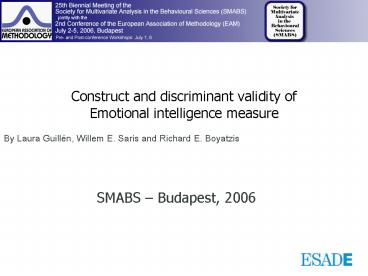Construct and discriminant validity of Emotional intelligence measure - PowerPoint PPT Presentation
1 / 19
Title:
Construct and discriminant validity of Emotional intelligence measure
Description:
... the empirical clustering reported by Batista-Foguet et al. (2006) and ... modify them deleting invalid variables (Batista-Foguet and Coenders, 2000): (1) ... – PowerPoint PPT presentation
Number of Views:52
Avg rating:3.0/5.0
Title: Construct and discriminant validity of Emotional intelligence measure
1
Construct and discriminant validity of Emotional
intelligence measure
By Laura Guillén, Willem E. Saris and Richard E.
Boyatzis
- SMABS Budapest, 2006
2
OBJECTIVE
Increase knowledge of emotional intelligence and
contribute to offer an appropriate model to be
used and developed within Spanish organizational
settings.
3
Why?
- The concept of emotional intelligence (EI)
resonates in the business world (Domagalski,
1999) and many authors have called for more
research that clearly conceptualized it (e.g.
Sala, 2002 Becker, 2003, Day and Carroll, 2004).
- Construct validity is still a limitation.
- Discriminant validity is challenged by the
statements that claim that EI does not explain
much more than other well-known psychological
constructs (Davies, Stankov and Roberts, 1998
Schulte et al., 2004) - EI has proven resistant to adequate measurement
(Schutte, Malouff, Hall, haggerty, Cooper, Golden
and Dornheim, 1998 Dulewicz, Higgs and Slaski,
2003).
4
Specific Objectives of the paper
- EI Theory of Performance Model of Goleman and
Boyatzis (Goleman 1995, 1998 Boyatzis, 1982 and
Goleman, Boyatzis and McKee, 2000). - Big Five Personality Model (e.g. Costa and
McCrae, 1992). - Construct validity
- Internal structure of a self-report EI
instrument. - The notion of consensus scores
- Discriminant Validity
- EI and Personality discriminant validity.
- Low to moderate correlations are expected 1)
Component of emotions 2) Self- vs. Consensus-
scores 3) Contextualization of the models 4)
Descriptive vs. Predictive approximations and,
5) Other studies (e.g. Murensky, 2000).
5
Methods
- Participants
- 120 employees of two medium-sized public
companies within the Spanish context. - 120 reported gender (77 women and 43 men) and 110
reported age (mean 38.44 SD 9.45) - Measurement Instruments
- ECI-2 72 items with response categories based on
frequency of demonstration or observation (each
item on a scale of 1 to 5) of specific
behaviours. - Eighteen competencies result the test that are
grouped into four theoretical clusters. - Spanish translation provided by HayGroup.
- NEO-FFI 60 items of the Revised NEO Personality
Inventory (NEO-PI-R) - Five domains of adult personality Neuroticism,
Extroversion, Openness to Experience,
Agreeableness, Conscientiousness.
6
Methods
- Procedure
- 120 completed the ECI-2 (self-, others- and
consensus scores). - 82 completed the NEO-Five-Factor Inventory.
- Design and Strategy of Analysis.
- CFA General EI model was divided into simplier
ones (CFA with 72 items in small samples presents
serius problems, Boomsma, 1993). - Groups were formed following the empirical
clustering reported by Batista-Foguet et al.
(2006) and respecting the theoretical clusters
(Goleman et al., 2002).
7
Methods
- EI Model (Goleman, Boyatzis and McKee, 2002)
8
Methods
- Groups
Group 1
Group 2
Group 3
Group 7
Group 4
Group 6
Group 5
9
Methods
- Design and Strategy of Analysis.
- CFA without restricting the relationships between
the items and the factors, except for
identification restrictions that were chosen in
line with the factor structure expected. - Looping process adding restrictions
progressively. - To adjust the models and modify them deleting
invalid variables (Batista-Foguet and Coenders,
2000) (1) items with loadings lower than .40 in
the correspondent factor were deleted due to poor
quality and, (2) items with loadings higher than
.40 in other factor that is not theoretically
appropriate were deleted due to theoretical
invalidity. - Unweighted summated scales were calculated.
- Then, the structure of subsequent models with the
appropriate items was assessed. - Unweighted summated scales were calculated.
10
Results
Three competences of the model (Accurate
Self-Assessment, Influence and Conflict
Management) were omitted.
11
Results Internal structure of the ECI-2
Three competences of the model (Accurate
Self-Assessment, Influence and Conflict
Management) were omitted.
12
Results Internal structure of the ECI-2
- Reliabilities and Correlation matrix
13
Results
- EFA The Big Five personality model was
assesed.
14
Results
- Correlations between personality traits and
emotional competencies were calculated
15
Results
- Regressions predicting Emotional Competencies
16
Results
- Coefficients
17
Discussion
- Construct Validity of EI
- The findings are in agreement with the
behavioural competencies conceptual framework of
EI. - A major limitation is sample size.
- Consensus scores
- Competence correlations
- Invalid or poor items/competencies
- Construct Validity of Personality
18
Discussion
- Discriminant Validity
- Correlations between personality traits and
emotional competencies are low to moderate - Extroversion and Conscientiousness are purported
to be the most important personality factors to
predict emotional competencies - The percentage of total variation of the
competencies explained by the personality traits
ranged from 0,074 to 0,185.
19
- Questions?































